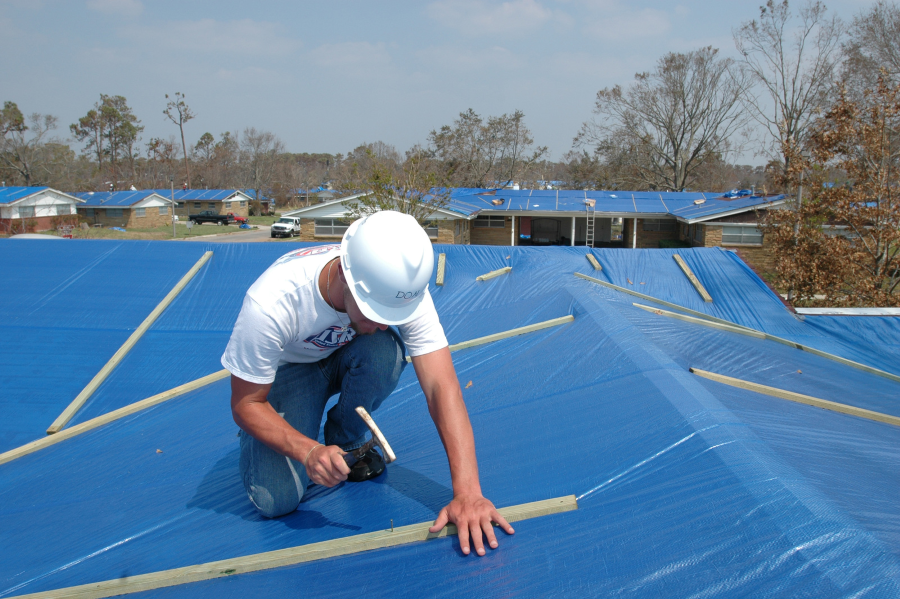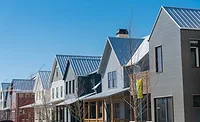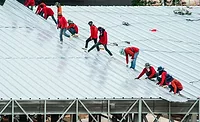Economic Indicators
Asphalt Roofing Product Shipments Drop in Q1 2023, Construction Data Underscores Decline
Report by the Asphalt Roofing Manufacturers Association shows a marked drop and could be the canary in a coal mine

Image courtesy of Wikipedia
The Asphalt Roofing Manufacturers Association released its first Quarterly Product Shipment Report for 2023. The numbers aren’t bullish, with shipments of asphalt roofing products declining more than 20% from a year earlier.
The report covers asphalt roofing product shipments in the United States and Canada in the first quarter, year-to-date shipment information and a comparison with the prior year’s data. Year-over-year, domestic shipments of asphalt roofing products were down 21.2% from Q1 2022 — 33.8 million from 42.9 million, respectively. Shipment amounts are measured in squares.
Canada, unsurprisingly a smaller market relative to its southern neighbor, did not escape a decline either, showing a first-quarter drop of 4.5% in 2023 with 3.3 million squares shipped versus 3.54 million during the same period a year earlier.
 The report also looked at roofing material beyond asphalt shingles, including built-up roofing base, ply roofing and mineral cap sheets. The U.S. market decline was precipitous here, too, down 24.2% from a year ago, with 1.37 million squares shipped from January-March 2023 versus 1.81 million during the first quarter of 2022.
The report also looked at roofing material beyond asphalt shingles, including built-up roofing base, ply roofing and mineral cap sheets. The U.S. market decline was precipitous here, too, down 24.2% from a year ago, with 1.37 million squares shipped from January-March 2023 versus 1.81 million during the first quarter of 2022.
Modified bitumen, typically used on low-slope roofs and known as the “evolutionary cousin” to BUR, made of asphalt combined with polymerized rubber or plastic, then reinforced with fiberglass creating a waterproof membrane, declined slightly by 2.3% year-over-year, with 9.6 million squares shipped in the first quarter of ’23 versus 9.85 million squares in Q1 of 2022.
According to Dow Jones’ MarketWatch, construction data last month underscores ARMA’s first quarter numbers in the aggregate. Construction of new homes fell 0.8% in March to a rate of 1.42 million due to slower work on apartment buildings, leaving prospective buyers with limited options.
Economists polled by the Wall Street Journal had forecast a 1.4 million rate of new housing starts. A sliver of silver in the numbers noted construction of single-family homes rose 2.7%. According to analysts, this year's small rebound in new construction is supported by strong demand from buyers, who are running out of options on the resale market that helped offset the decline in apartment projects.
Building permits, a key indicator of the pace of future construction, fell a sharper 8.8% to a 1.41 million annualized rate, the government said on April 18, when the data was made public. The decline was greater than economists expected. All figures are seasonally adjusted.
The same day the government released its March numbers, the National Association of Home Builders announced its monthly confidence index rose a point to 45 in April, which is the fourth consecutive month that sentiment has improved. The WSJ said the rise matched expectations on Wall Street, and the 45 reading was the strongest since September 2022.
Key Details
- Single-family-home construction rose the most in the Midwest, with a 23.6% increase.
- Pace of construction on apartments fell by 6.7%.
- Permits for single-family homes rose 4.1% in March, while permits for buildings with at least five units fell by 24.3%.
Yet overall, housing starts are down year over year, with the annual rate of total housing starts falling 17.2% from the previous year. The dip in domestic housing starts, analysts say, is primarily due to a slowdown in multi-unit rental construction, which had been booming over the last few months but has cooled as new units hit the market. Rent inflation is also slowing, signaling that consumers may have more options on the supply side.
And with a multi-million-unit shortage of housing that traces its genesis to the Great Recession of 2008 and the dearth of previously owned homes available, the NAHB says buyers are increasingly turning to new builds despite the increase in interest rates.
 The NAHB said on April 17 that new construction has increased market share from one-tenth to one-third of housing sales, and builders are “pretty optimistic” about the future.
The NAHB said on April 17 that new construction has increased market share from one-tenth to one-third of housing sales, and builders are “pretty optimistic” about the future.
“New home inventories had gotten bloated last year when demand sank … builders slammed on the brakes in terms of starts, and the pipeline of new single-family homes under construction has thinned considerably,” Stephen Stanley, chief U.S. economist at Santander U.S. Capital Markets wrote in a note to MarketWatch.
“My sense is that barring a significant pickup in new home sales, builders have more work to do in getting inventories down,” Stanley added. “Which means that, even if housing starts are in the process of bottoming out, they are unlikely to strengthen considerably in the near term.”
Others expected a softer U.S. economy to start affecting home builders, too, despite mortgage rates that were slightly lower than when the year began.
“Although home purchase intentions were supported by lower mortgage rates in March, we expect mortgage rates to rise in the coming months as markets push rate cut expectations into 2024, compounding the impact of tighter lending standards as a barrier to homebuilding ahead,” Katherine Judge at CIBC Economics said in an analysis about the government’s latest numbers.
The ARMA report reflects these trends and indicates that contractors must become creative to keep the momentum going.
“Asphalt roofing data is relevant and meaningful to a number of industries,” said ARMA’s Executive Vice President Reed Hitchcock. “The shipment report provides valuable insight into the asphalt roofing industry to ARMA members, trade professionals, and other interested parties.”
Companies not members of ARMA may examine the free quarterly summaries, and those ineligible for ARMA membership may subscribe to the full, detailed report on its website.
Looking for a reprint of this article?
From high-res PDFs to custom plaques, order your copy today!





.webp?height=200&t=1735849515&width=200)


